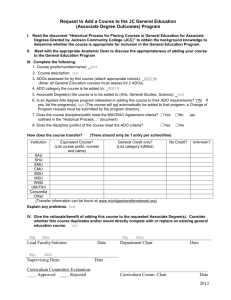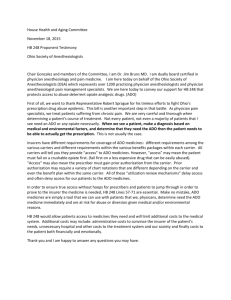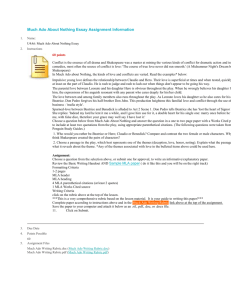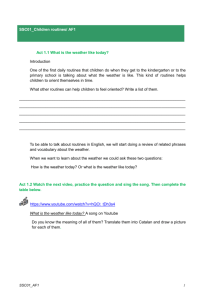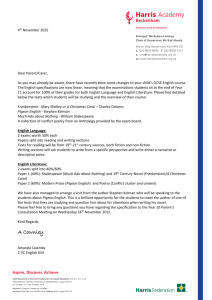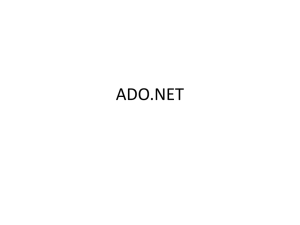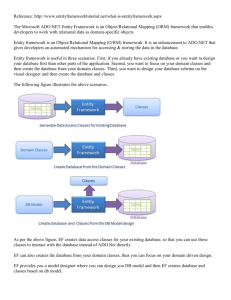Example and Guidelines for a Subpart 21.J
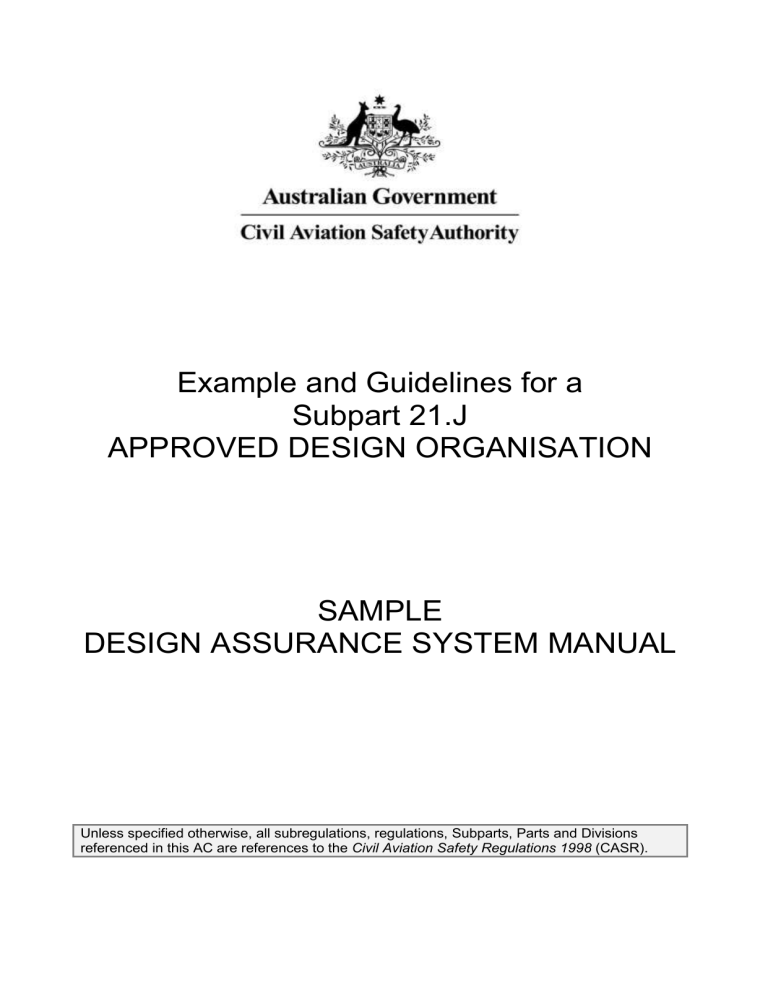
Example and Guidelines for a
Subpart 21.J
APPROVED DESIGN ORGANISATION
SAMPLE
DESIGN ASSURANCE SYSTEM MANUAL
Unless specified otherwise, all subregulations, regulations, Subparts, Parts and Divisions referenced in this AC are references to the Civil Aviation Safety Regulations 1998 (CASR).
EXPLANATORY STATEMENT
This document provides guidance on the structure and content of an approved design organisation (ADO) design assurance system manual (DASM) as required under regulation
21.267.
Regulation 21.267 specifies high level requirements for the contents of the DASM. In practice, the detailed procedures necessary to comply with these requirements will depend on the size of an organisation and the scope of its ADO privileges. Nevertheless, there are elements of any design assurance system that are common to the various design activities defined under
Subpart 21.J. This sample manual contains system elements acceptable to CASA as a means of satisfying the high level regulatory requirements of a design assurance system for the design activities undertaken by an ADO.
The document is a mixture of requirements and guidance under recommended headings. It is recommended that ADOs retain the headings and expand as necessary to suit the organisation.
The text provided under each section or subsection provides guidance on the nature of contents to be included. The sections and subsections should be further expanded according to the complexity of the processes and procedures of the ADO.
It is important for the users of this sample document to appreciate that no single sample DASM can meet the needs of all types and sizes of organisations or reflect their different organisational structures, policies and procedures. This document is for guidance only; the structure and content of the AD O’s DASM should reflect their structures, policies and procedures. CASA suggests the ADO use a compliance checklist/matrix to demonstrate to
CASA that the DASM fully addresses all applicable requirements of Subpart 21.J.
Where the content of the DASM requires processes and procedures to be provided, these may be included in other documents provided they are referenced in the DASM. However, in such instances, the other documents will form part of the DASM and be subject to the same requirements and controls. Processes and procedures included or referred to in the DASM should be of adequate depth and include enough details to demonstrate they establish compliance with the applicable requirements of Subpart 21.J.
Where the DASM specifies the duties and responsibilities of an individual or organisation, these should relate only to obligations under Subpart 21.J; they are not meant to cover employment conditions, performance criteria or administrative functions. Where content of the DASM involves identifying the individual responsible for an action or a decision that is part of a process, CASA intends that the individual will be identified by their position title (such as ‘
Head of Design ) or, if applicable, by means that d escribe their function (such as ‘ persons authorised to carry out approval activities
’ or ‘ independent checkers’
).
CASA recommends worksheets, checklists, forms, lists of items and personnel etc., when either required under the DASM or associated with the processes or procedures required by the DASM, should be included as appendices at the end of the DASM. However, as mentioned above, they may be included in other documents that contain the processes and procedures or in any other document if it is convenient for the organisation to do so.
ADO Sample Design Assurance System Manual Page i
Insert Organisation Logo here
[ORGANISATION] ’S SUBPART 21.J
APPROVED DESIGN ORGANISATION
DESIGN ASSURANCE SYSTEM MANUAL
This design assurance system manual has been developed to meet the Civil Aviation Safety
Regulations 1998 (CASR) Subpart 21.J Approved Design Organisation design assurance system manual requirements.
Approved Design Organisation approval certificate reference number xxxxx
[Organisation]
Address 1
Address 2
Address 3
Telephone: xx xxxxxxx
Facsimile: xx xxxxxxxx
Email: xxxx@xxxx.xxx.xx
Document No: xxxxxxx Revision:
Copy Number: x of xx Holder Name:
TABLE OF CONTENTS
Providing employees (and subcontractors) with the DASM ............................ 8
Notification of errors, deficiencies or improvements ....................................... 8
Applying to CASA for approval of changes to the DASM ............................... 8
Direction by CASA to change the DASM ........................................................ 8
Design assurance system documents ............................................................ 9
Approved data and certificates issued by the ADO ........................................ 9
PART 2 PERSONS AUTHORISED TO CARRY OUT DESIGN ACTIVITIES ..................... 10
Minimum qualifications, knowledge and experience ..................................... 10
Candidate professional development program ............................................. 11
Identification of applicable airworthiness standards ..................................... 13
Identification of the relevant design requirements ........................................ 13
Compliance with conditions of approval certificate ....................................... 13
Compliance with other regulations ............................................................... 14
Equivalent level of safety determinations ..................................................... 15
ADO Sample Design Assurance System Manual Page 1
Adequacy and effectiveness of the DASM ................................................... 18
Compliance of ADO employees ................................................................... 18
Qualifications, knowledge and experience ................................................... 19
PART 5 OTHER CASR PART 21 AUTHORISATIONS ...................................................... 20
PART 6 APPENDIX A – ENGINEERING SPECIALTY DEFINITIONS ............................... 21
ADO Sample Design Assurance System Manual Page 2
LIST OF EFFECTIVE PAGES
This section should list the number of effective pages in each revision of the complete manual.
The list may be prepared in the following manner.
Page No. Revision Date Page No. Revision Date
ADO Sample Design Assurance System Manual Page 3
AMENDMENT RECORD
This section should set out the amendment record of the design assurance system manual.
The amendment record may be in the following form.
AMENDMENT OF THE DASM INCLUSION IN THE DASM
Amendment
No.
Date Details Included by Date
ADO Sample Design Assurance System Manual Page 4
DISTRIBUTION LIST
This section should include a distribution list to ensure adequate distribution of the Design
Assurance System Manual (DASM) and to demonstrate to CASA that all personnel involved in design activities have access to the relevant information. This does not mean that all personnel have to be in receipt of a complete DASM but that a reasonable number of copies are readily available within the organisation.
Alternately, if the manual is available electronically then this section should set out how the electronic version is made available within the organisation and to individuals outside the organisation.
The distribution list for hard copies may be in the following form.
Copy No. Holder
ADO Sample Design Assurance System Manual Page 5
ABBREVIATIONS, ACRONYMS AND DEFINITIONS
This section should set out the meaning of any abbreviations, acronyms and unique terms used in the DASM. For example:
ADO ............................ Approved Design Organisation
CASR .......................... Civil Aviation Safety Regulations 1998
DASM ......................... Design Assurance System Manual
ADO Sample Design Assurance System Manual Page 6
PART 1 GENERAL
1.1 HEAD OF DESIGN STATEMENT
Note: Subpart 21.J does not require a particular head of design statement in the DASM. The sample text in this section may be used or omitted by the ADO; however, the DASM should include a section showing approval of the DASM by the head of design.
The Head of Design’s DASM statement should include a statement that conveys the intent of the following paragraphs. The following statement may be used without amendment. Any changes to the statement should not alter the intent.
This DASM defines the design assurance system procedures on which the Subpart 21.J of CASR approval of [ADO holder name] as an Approved Design Organisation (ADO) is based. The DASM procedures should be used in conjunction with the procedures for design a ctivities specified in the ADO’s exposition.
The DASM, along with the procedures contained in it, is approved by CASA. The ADO must comply with its DASM in order to ensure that all design activities are carried out to the standard required under the regulations.
The procedures included or referred to in this DASM do not preclude the need to comply with any new or amended regulation published by CASA from time to time.
Should any new or amended regulations conflict with these procedures, it is the responsibility of the ADO to update their procedures to reflect the intent of the regulations.
The ADO approval will continue whilst CASA is satisfied that the procedures described or referenced in this DASM are being followed.
Signed: ............................................
Name: ..............................................
Date: .............................................
Title: Head of Design
Organisation name
ADO Sample Design Assurance System Manual Page 7
1.2 DASM CHANGE CONTROL
(Regulations 21.255, 21.256 and 21.283, and AC 21.J-01 refer)
1.2.1 Providing employees (and subcontractors) with the DASM
This section sets out how the ADO ensures employees and subcontractors have access to the parts of the DASM that relate to their duties and responsibilities, and who is responsible for providing access.
1.2.2 Notification of errors, deficiencies or improvements
This section sets out the procedure for employees or subcontractors to propose amendments to the DASM due to perceived errors, deficiencies or improvements.
1.2.3 Amendment of the DASM
This section sets out the procedure to control draft amendments and incorporate changes to the DASM. It should also identify the individual responsible for incorporating the change in the DASM once it is approved by
CASA.
1.2.4 Applying to CASA for approval of changes to the DASM
The section sets out the procedures to make an application for change to
CASA, and to ensure the proposed changes comply with the regulations.
1.2.5 Direction by CASA to change the DASM
This section sets out how the ADO incorporates changes to its DASM to comply with a direction given by CASA. It should also identify the individual responsible.
1.3 DOCUMENT CONTROL
(Paragraph 21.269(2)(a) refers)
Effective document configuration control is essential to ensure that design activities are carried out in a controlled manner. This section sets out (or refers to) the procedures used to control the following types of documents:
technical data
design assurance system documents
approved data and certificates issued by the ADO.
The document control system should include procedures used to record the actions of persons authorised to carry out functions that alter the status of a document, such as
ADO design activity privileges or independent checkers. Procedures should detail the use of hard copy signatures or password-controlled computer-based document management systems, as applicable.
ADO Sample Design Assurance System Manual Page 8
1.3.1 Technical data
This section sets out the procedures used by the ADO to control technical data
(defined under regulation 21.008). This is applicable to data sourced externally or generated by the ADO.
1.3.2 Design assurance system documents
This section sets out the procedures used to control the documents generated by the ADO, as required by the DASM. These include compliance assurance and quality assurance documents.
1.3.3 Approved data and certificates issued by the ADO
This section sets out the procedures used to control the approved data and certificates generated by the ADO, as applicable to the approval activity and certification activity privileges.
ADO Sample Design Assurance System Manual Page 9
PART 2 PERSONS AUTHORISED TO CARRY OUT DESIGN
ACTIVITIES
(Regulations 21.269(1) and (2), and AC 21.J-01 refer)
The ADO ’s design activities must be carried out by persons with appropriate qualifications, knowledge and experience to ensure that the technical airworthiness requirements of paragraph 21.269(2)(a), and the safety requirements of paragraph 21.269(2)(b), are met. This part of the DASM sets out the policy and procedures for the identification of suitably qualified and experienced candidates to conduct an ADO’s design activities (see Section 2.1).
For very small organisations, it may be that the Head of Design is the only person authorised to carry out design activities. For larger organisations, it would typically be necessary for the Head of Design to authorise others to carry out design activities. This part of the DASM sets out the policy and procedures for the appointment of persons authorised to carry out the ADO
’s design activities (refer Sections 2.2 and 2.3).
The ongoing effectiveness of the design assurance system relies on persons authorised to carry out design activities being kept up-to-date with technical, procedural and regulatory requirements of the functions they perform. It is therefore essential that such personnel receive ongoing professional development appropriate to their function. This part of the DASM also sets out the policy and procedures for ensuring that persons authorised to carry out the ADO ’s design activities are provided with effective ongoing professional development (see
Section 2.4).
2.1 CANDIDATE IDENTIFICATION AND TRAINING
This section sets out the policy and procedures for the identification and training of candidates for design activity authorisations. The system should ensure candidates have appropriate training and mentoring by persons experienced in carrying out the relevant ADO design activities. Training should include technical, procedural and regulatory aspects of the function. Consideration should be given to the following:
2.1.1 Minimum qualifications, knowledge and experience
This section should refer to the relevant sections of the exposition that specify the minimum qualifications, knowledge and experience criteria for each person authorised to carry out a design activity.
For example, the academic qualifications required are typically an engineering degree, or equivalent, in a mechanical or aeronautical discipline for structures and mechanical systems, augmented by training and experience for propellers and engine specialities.
The flight analyst specialty typically requires education in aeronautics, specialist training as a flight test engineer and significant relevant flight test evaluation experience.
For electrical, instrument and radio specialties, electrical/electronics-related academic qualifications are typically required.
The software specialty requires a relevant engineering degree plus specialist training and experience in software design and development.
The materials specialty needs qualifications in metallurgy or material sciences.
Additional details and requirements regarding acceptable minimum qualifications, knowledge and experience are provided in the AC 21.J-01 and the ADO Sample Exposition.
ADO Sample Design Assurance System Manual Page 10
2.1.2 Candidate professional development program
This section sets out (or refers to) the system of professional development that is used to ensure the candidate is provided with appropriate training and development. This could include formal training, on-the-job training and exposure to a range of appropriate roles or projects. The training and development events should be recorded.
2.1.3 List of work samples
This section sets out the procedure to produce a candidate ’s list of work samples when the candidate has demonstrated an acceptable level of competence by carrying out the tasks associated with the design activity under the supervision of an authorised supervisor.
2.2 CANDIDATE ASSESSMENT
This section sets out the policy and procedures for assessment of candidates for design activity authorisations.
2.2.1 Candidate eligibility
This section sets out the procedure to check a candidate ’s eligibility for design activity authorisations, by comparison with exposition and DASM criteria for minimum qualifications, experience and samples of work.
2.2.2 Knowledge assessment
This section sets out the procedure to assess the knowledge of the candidate.
The procedure should include:
(a) an assessment of candidate knowledge related to technical, procedural and regulatory aspects of the relevant activity
(b) an interview with the Head of Design and at least one other person forming the interview panel. The panel members should collectively hold authorisations for all the relevant ADO design activities and engineering specialties.
(c) how the assessment process is to be documented.
2.3 FORM OF AUTHORISATION
This section sets out the policy and procedure for promulgating the authorisation to the individual and to the organisation. The authorisation should specify the authorised design activities, applicable aircraft or aeronautical products, the scope in terms of the engineering specialties (refer Appendix A), and any other limitations.
Authorisations must be within the scope and limitations of the ADO approval certificate.
ADO Sample Design Assurance System Manual Page 11
2.4 PROFESSIONAL DEVELOPMENT PROGRAM
This section sets out the policy and procedures to ensure that persons authorised to carry out the ADO ’s design activities are provided with effective ongoing professional development. Professional development could include formal training courses, on-thejob training and regular exposure to a range of appropriate roles or projects. The procedure should specify how the training and development events for each person is planned and recorded.
ADO Sample Design Assurance System Manual Page 12
PART 3 COMPLIANCE ASSURANCE SYSTEM
(Subregulations 21.269(1), (2) and (4), and AC 21.J-01 refer)
3.1 COMPLIANCE PLANNING
Design compliance should be systematically planned prior to generation of the technical data for a design, to ensure that the ADO addresses all relevant design requirements of the applicable airworthiness standards. Compliance planning procedures should address the elements described in the following subsections.
3.1.1 Identification of applicable airworthiness standards
This section sets out the procedure to identify and record the applicable airworthiness standards, for an aircraft or aeronautical product subject to a design activity. The procedure should address the following:
(a) Certification basis: Definition of the current certification basis of the aircraft or aeronautical product before the design activity is undertaken, including consideration of the aircraft Type Certificate, type acceptance certificate, or approved aeronautical product specification, and any additional airworthiness requirements specified in the Australian civil aviation regulations for the aircraft or aeronautical product.
(b) Adequate safety standard determination: An assessment of whether the current certification basis provides an adequate level of safety for the aircraft or aeronautical product when subject to the design activity, and if subsequent or additional airworthiness standards or special conditions will be required.
(c) Non-applicable design requirements: If the ADO considers that specific requirements of the applicable airworthiness standard do not apply to the purpose for which the aircraft is to be used, then an application must be made to CASA, via a Design Advice, for a determination that the requirements do not apply to the stated design activity.
3.1.2 Identification of the relevant design requirements
This section sets out the procedure to identify those design requirements of the applicable airworthiness standards that are relevant to the design activity.
3.1.3 Compliance with conditions of approval certificate
This section sets out the procedure to ensure that the design activity is carried out within the scope and limitations of the
ADO’s approval certificate. This process should take into account the design activity privileges, applicable aircraft and aeronautical products engineering specialities, and any limitations specified.
ADO Sample Design Assurance System Manual Page 13
3.1.4 Compliance with other regulations
This section sets out the procedure to ensure that the design activity is carried out in compliance with other relevant design and airworthiness regulations.
3.1.5 Means of compliance
This section sets out the procedure used to determine the means of compliance for each of the relevant design requirements in the applicable airworthiness standards.
3.1.6 Equivalent level of safety provisions
This section sets out the procedure used to propose an equivalent level of safety provision(s) for a design activity. The procedure should identify and document the compensating factors that provide an equivalent level of safety to that afforded by the applicable airworthiness standard.
3.1.7 Compliance plan
This section sets out the procedure used to develop the compliance plan for design activities. The compliance plan should:
(a) describe the affected aircraft system or aeronautical product
(b) describe the design change applicable to the design activity
(c) identify the applicable airworthiness standards
(d) identify the relevant design requirements
(e) specify the means by which compliance with each relevant design requirement would be demonstrated
(f) identify the design activities to be carried out and the persons responsible for each activity.
3.2 COMPLIANCE DEMONSTRATION
This section sets out the procedure to demonstrate compliance as set out in the compliance plan.
3.2.1 Technical data
This section sets out (or refers to) the procedures used by the ADO to generate and/or manage the technical data (as defined in regulation 21.008) applicable to the design activity.
ADO Sample Design Assurance System Manual Page 14
3.2.2 Testing
This section sets out the procedures to manage certification testing. The procedures should address:
(a) test article conformity
(b) calibration of equipment
(c) inspections and witnessing of tests
(d) reporting requirements
3.2.3 Compliance summary
This section sets out the procedure used to collate the outcome of tasks specified in the certification plan into a summary document that demonstrates that compliance with relevant design requirements has been achieved.
The procedure should highlight any design requirements that require an equivalent level of safety determination.
3.3 COMPLIANCE FINDING
This section sets out the procedure to record the finding of compliance by persons authorised to approve or certify the design, as applicable to the design activity.
3.3.1 Statement of compliance
This section sets out the procedure to complete the statement of compliance for the design activity, using CASA form 979 (or equivalent) with appropriate references or attachments.
3.3.2 Equivalent level of safety determinations
This section sets out the procedure to:
(a) make an equivalent level of safety determination, if the ADO is granted the privilege, or
(b) apply to CASA for a determination via a Design Advice.
3.4 ENSURING NO UNSAFE FEATURES OR CHARACTERISTICS
This section sets out the procedure to make a determination that the design activity does not introduce an unsafe feature or characteristic to the aircraft or aeronautical product. The procedure should specify how and where the determination is recorded.
ADO Sample Design Assurance System Manual Page 15
3.5 MAJOR/MINOR CLASSIFICATION
This section sets out the procedure to classify damage or design changes as either major or minor. Consideration should be given to:
(a) AC 21-12
(b) how the basis of the decision is to be recorded.
3.6 SUBMITTING A DESIGN ADVICE TO CASA
This section sets out the procedure to submit a Design Advice to CASA. The procedure should address:
(a) the conditions under which a Design Advice must be submitted as specified in the approval certificate and/or exposition
(b) the use of CASA form 655 with appropriate attachments
(c) mechanisms to ensure that CASA ’s response is addressed before completion of the design activity
(d) identification of persons responsible for submission of the design advice.
3.7 INDEPENDENT CHECKING
The technical data, design assurance system documents and advice, and approved data or certificates to be issued by the ADO should be checked by a competent, independent individual.
This section sets out the policy and procedures to independently check a design activity. The procedures should address:
(a) the qualifications, knowledge and experience requirements for checkers
(b) independence criteria
(c) the appointment of checkers to a particular design activity
(d) the scope of the checker function, including assumptions, methodology, calculations and conclusions
(e) the use of checklists to record the checking of design assurance system requirements
(f) how the checking activity is recorded
(g) draft document amendment control.
ADO Sample Design Assurance System Manual Page 16
PART 4 QUALITY ASSURANCE SYSTEM
(Subregulation 21.269(3) and AC 21.J-01 refer)
This part sets out the policy and procedures for monitoring the effectiveness of the design assurance system, and compliance of the ADO and its subcontractors with the design assurance system procedures. The quality assurance system should enable the ADO to effectively identify deficiencies in procedures and practices and address those deficiencies through a process of continual improvement.
4.1 REPORTING ERRORS AND DEFICIENCIES
This section sets out the policy and procedure for the reporting of errors and deficiencies from ADO employees or external sources. The procedure should specify
(a) the form used to record the perceived error or deficiency
(b) how the status of each report should be monitored
(c) the persons responsible for report management.
4.2 INVESTIGATIONS
This section sets out the procedure to conduct investigations into reported errors or deficiencies in the design assurance system. The following subsections should be included.
4.2.1 Root cause
Sets out the procedure to identify and record the root cause of an error or deficiency.
4.2.2 Corrective action
Sets out the procedure to determine and initiate an appropriate action to address the error or deficiency.
4.2.3 Preventive action
Sets out the procedure to determine and initiate an appropriate action to prevent a recurrence of the error or deficiency.
4.2.4 Reporting
Sets out the procedure to report the outcomes and actions of the investigation to the Head of Design.
4.2.5 Responsible persons
Sets out the procedure to appoint persons responsible for the conduct of investigations.
ADO Sample Design Assurance System Manual Page 17
4.3 INDEPENDENT MONITORING
This section sets out policy and procedures to independently monitor the adequacy of the design assurance system and the ADO’s compliance with the design activity procedures specified in the DASM and exposition. The procedures should specify the methods used to assess system effectiveness and compliance, and describe how monitoring activities should be planned and recorded.
The following subsections should be included.
4.3.1 Adequacy and effectiveness of the DASM
Sets out the procedure to monitor the adequacy and effectiveness of the DASM procedures, to ensure:
(a) designs comply with applicable airworthiness standards
(b) no design activity introduces an unsafe features or characteristic to an aircraft or aeronautical product
(c) compliance with Part 21
(d) compliance with the ADO approval certificate conditions.
4.3.2 Compliance of ADO employees
Sets out the procedure to monitor compliance of ADO employees with the
DASM and exposition.
4.3.3 Compliance of subcontractors
Sets out the procedure to monitor compliance of subcontractors with the DASM and exposition.
4.3.4 Reporting
Sets out the procedure to report the findings of independent monitoring activities to the Head of Design. Consideration should be given to the classification of findings based on type, such as:
(a) errors and deficiencies in technical data
(b) errors and deficiencies in design assurance system documents
(c) errors and deficiencies in approved data, certificates or advice issued by the ADO
(d) non-compliance with DASM or exposition procedures
(e) observations of perceived deficiencies in processes or practices that have the potential to cause errors or non-compliances.
ADO Sample Design Assurance System Manual Page 18
4.3.5 Acquittal of findings
Sets out the procedure to acquit the findings of independent monitoring activities. For each type of finding (see Section 4.3.4), the acquittal procedure should be specified and may include:
(a) the initiation of an investigation (Section 4.2 refers)
(b) acceptable timeframes for acquittal.
4.3.6 Qualifications, knowledge and experience
Sets out the qualifications, knowledge and experience requirements for persons carrying out independent monitoring.
4.3.7 Independence criteria
Sets out the independence criteria for persons carrying out independent monitoring.
4.3.8 Responsible persons
Sets out the procedure to appoint persons responsible for the conduct of independent monitoring and ensuring findings are acquitted in an acceptable timeframe.
ADO Sample Design Assurance System Manual Page 19
PART 5 OTHER CASR PART 21 AUTHORISATIONS
(Regulation 21.270 refers)
This section sets out (or refers to) the procedures for complying with obligations as the holder of other Part 21 authorisations.
5.1 TC
5.2 STC
5.3 PC
5.4 APMA
5.5 ATSO
5.6 SUBPART 21.M
ADO Sample Design Assurance System Manual Page 20
PART 6 APPENDIX A – ENGINEERING SPECIALTY DEFINITIONS
This section should list the engineering specialty definitions.
6.1 STRUCTURES
A Structures specialty authorisation allows the holder to make findings of compliance and approve engineering reports, drawings and data relating to the design of aircraft structures, including materials and processes used.
Structures include the airframe fixed structure and structural aspects of moveable control surfaces, landing gear, doors, covers, fairings and equipment mounting.
6.2 SYSTEM AND EQUIPMENT (MECHANICAL)
A System and Equipment (Mechanical) specialty authorisation allows the holder to make findings of compliance and approve engineering reports, drawings and data relating to the design of aircraft mechanical systems and equipment, including materials and processes used.
Mechanical systems and equipment includes:
wheels
tyres
brakes
landing gear
hydraulics
pneumatics
mechanical control systems
fuel systems
pressurisation
air-conditioning
oxygen
cabin and cargo compartment interiors and materials (including flammability requirements)
seats
safety equipment
mechanical aspects of powerplant installations not covered by the engine or propeller design standards (e.g. FAR 33 or FAR 35).
6.3 SYSTEMS AND EQUIPMENT (ELECTRICAL)
An Electrical specialty authorisation allows the holder to make findings of compliance and approve engineering reports, drawings and data relating to the design of aircraft electrical systems, including materials and processes used.
Electrical speciality includes:
electrical power generation, storage, distribution and protection systems
lighting systems
mission-specific additions or modifications (i.e. night sun, night vision compatible lighting, provision of power to role equipment etc.)
fire/smoke detection systems
combustion heaters
aircraft electrical bonding
ADO Sample Design Assurance System Manual Page 21
data busses and multiplexing systems associated with the functioning of electrical systems
warning indicators/annunciator panels.
6.4 SYSTEMS AND EQUIPMENT (ELECTRICAL – LIMITED)
An Electrical
– Limited specialty authorisation allows the holder to make a finding of compliance for the following tasks:
repair, temporary/permanent removal and subsequent re-installation of existing equipment or simple systems
design of new equipment or system installations, provided that any integration with other aircraft systems is done in accordance with the equipment manufacturer’s installation instructions
modification of existing equipment or system installations, provided that any integration with other aircraft systems is done in accordance with the equipment manufacturer’s installation instructions.
6.5 SYSTEMS AND EQUIPMENT (INSTRUMENT)
An Instrument specialty authorisation allows the holder to make findings of compliance and approve engineering reports, drawings and data relating to the design of aircraft instrument systems, including materials and processes used.
Instrument speciality includes:
all indicating system instruments, composite indicators, multi-function displays and associated plumbing/wiring, but excluding radio system indicating equipment and electrical meters
automatic flight control systems
integrated flight systems
flight performance management systems
pitot static systems
air data systems
oxygen systems
inertial navigation/inertial reference systems
data busses and multiplexing systems associated with instrument systems
data recording systems including flight data recorder systems, health monitoring systems, engine parameter recording systems etc.
Terrain Awareness & Warning System (TAWS), including ground proximity warning systems but excluding radio inputs
stall warning/indicating systems
electronically displayed check lists, including some EFB but excluding radar displays
Head-up Displays
Synthetic Vision Systems
Enhanced Vision Systems
Infra-red systems
Active noise and vibration cancelling systems
mission-specific additions or modifications (e.g. instrument pods, camera systems etc.).
ADO Sample Design Assurance System Manual Page 22
6.6 SYSTEMS AND EQUIPMENT (INSTRUMENT – LIMITED)
An Instrument – Limited specialty authorisation allows the holder to make findings of compliance for the following tasks:
repair, temporary/permanent removal and subsequent re-installation of existing equipment or simple systems
design of new equipment or system installations, provided that any integration with other aircraft systems is done in accordance with the equipment manufacturer’s installation instructions
modification of existing equipment or system installations, provided that any integration with other aircraft systems is done in accordance with the equipment manufacturer’s installation instructions.
6.7 SYSTEMS AND EQUIPMENT (RADIO)
A Radio specialty authorisation allows the holder to make findings of compliance and approve engineering reports, drawings and data relating to the design of aircraft radio systems, including materials and processes used.
Radio speciality includes:
communication systems, including emergency transmitters
navigation systems (both terrestrial and satellite)
composite indicators, excluding indicators containing gyroscopes
audio distribution systems
cockpit voice recorder systems
data busses and multiplex systems associated with radio systems
in-flight entertainment systems
radar systems, including weather radar, radio altimeter and associated TAWS inputs
transponders
collision avoidance systems
mission-specific additions or modifications (i.e. telemetric systems, role equipment using active transmitters etc.)
securing the radio unit within its case/rack, the interwiring of radio components and the bonding of all components of the radio system to the aircraft structure.
6.8 SYSTEMS AND EQUIPMENT (RADIO – LIMITED)
A Radio – Limited specialty authorisation allows the holder to make findings of compliance for the following tasks:
repair, temporary/permanent removal and subsequent re-installation of existing equipment or simple systems
design of new equipment or system installations, provided that any integration with other aircraft systems is done in accordance with the equipment manufacturer’s installation instructions.
modification of existing equipment or system installations, provided that any integration with other aircraft systems is done in accordance with the equipment manufacturer’s installation instructions.
Note on Electrical, Instrument and Radio specialties: The instrument system wiring to the electrical power supply terminates at the distribution bus and includes the circuit breaker or fuse. The instrument system wiring supplying data signals to the radio system terminates at the connection to the radio system equipment or junction box. The
ADO Sample Design Assurance System Manual Page 23
radio wiring to the power supply of the electrical system terminates at the radio distribution bus and includes the circuit breaker or fuse.
6.9 SOFTWARE
A Software specialty authorisation allows the holder to make findings of compliance and approve engineering reports, drawings and data relating to the design of aircraft software.
The software specialty includes:
discrete software applications and operating systems installed in airborne electronic systems
the airborne electronic hardware systems fitted with custom micro-coded
(programmable) components (e.g. application specific integrated circuits or programmable logic devices).
There are three categories of software covered by a Software specialty authorisation:
flight critical (i.e. software levels A and B, and hardware levels A and B)
flight non-critical (i.e. software levels C and D, and hardware levels C and D)
non-flight related (i.e. software level E and hardware level E).
The categories identified above are as described in RTCA/DO-178B Paragraph 2.2.2 and DO-254 Table 2-1.
6.10 ENGINE
An Engine specialty authorisation allows the holder to make findings of compliance and approve engineering reports, drawings and data relating to the design of aircraft engines, including materials and processes employed in engine design, operation and maintenance.
6.11 PROPELLER
A Propeller specialty authorisation allows the holder to make findings of compliance and approve engineering reports, drawings and data relating to the design of aircraft propellers, including materials and processes employed in propeller design, operation and maintenance.
6.12 FLIGHT ANALYST
A Flight Analyst specialty authorisation allows the holder to make findings of compliance with applicable aircraft flight requirements including performance, handling, stability and control. A Flight Analyst is responsible for ensuring that adequate flight tests are carried out and for the proper review and analysis of flight test data necessary to make findings of compliance. In addition, the Flight Analyst is responsible for recommending approval of flight manual performance data.
6.13 MATERIAL AND PROCESS
A Material and Process specialty authorisation allows the holder to make findings of compliance and approve engineering reports, drawings and data relating to material and
ADO Sample Design Assurance System Manual Page 24
process specifications, including metallic or composite materials, fasteners, fluids, resins and consumables.
ADO Sample Design Assurance System Manual Page 25

